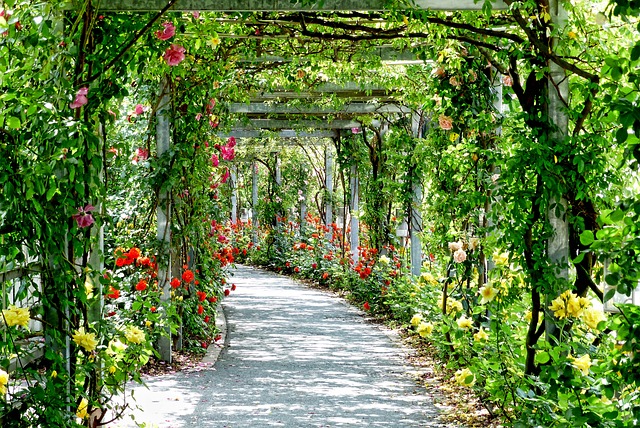Whimsical Wonderland: The Enchanting World of Storybook Gardens
Step into a realm where fantasy meets horticulture, where every corner tells a tale, and where imagination blooms alongside vibrant flora. Storybook gardens, a captivating trend in landscape design, are transforming ordinary outdoor spaces into magical wonderlands that delight both young and old. These enchanting gardens bring beloved literary worlds to life, creating immersive experiences that transport visitors to the pages of their favorite books.

The Origins of Storybook Gardens
The concept of storybook gardens can be traced back to the early 20th century when landscape architects began experimenting with themed gardens. These early iterations were often found in public parks and botanical gardens, designed to educate and entertain visitors. The first notable storybook garden was created in 1956 in London, Ontario, Canada, aptly named “Storybook Gardens.” This pioneering project set the stage for a new genre of landscape design that would captivate generations to come.
As the idea gained popularity, more storybook gardens began to sprout up around the world. In the United States, Disneyland’s Storybook Land Canal Boats, which opened in 1955, became an iconic example of how storytelling could be woven into landscape design. These early examples paved the way for a broader trend that would eventually find its way into private homes and community spaces.
Elements of a Storybook Garden
Creating a storybook garden is an art form that combines traditional landscaping techniques with theatrical set design. Key elements often include:
-
Themed plant selections: Choosing flora that matches the story’s setting or characters.
-
Miniature architecture: Small-scale buildings, bridges, or castles that represent key locations from the tales.
-
Interactive features: Elements that encourage exploration, such as secret pathways or hidden nooks.
-
Water features: Ponds, streams, or fountains that add movement and sound to the garden.
-
Whimsical sculptures: Character statues or abstract art pieces that bring the stories to life.
-
Lighting: Strategic illumination to create a magical atmosphere, especially in the evenings.
-
Signage and storytelling elements: Plaques or books that guide visitors through the narrative of the garden.
Designing Your Own Storybook Garden
Bringing the magic of storybook gardens to your own space doesn’t require acres of land or a Disney-sized budget. Here are some tips for creating your own enchanted outdoor area:
-
Choose your story: Select a theme based on your favorite book or a collection of tales. This will guide your design choices and plant selections.
-
Start small: Begin with a corner of your yard and gradually expand as you refine your vision and skills.
-
Incorporate vertical elements: Use trellises, archways, or climbing plants to create the illusion of entering a different world.
-
Play with scale: Mix miniature elements with full-size plants to create a sense of wonder and perspective.
-
Add sensory experiences: Include fragrant plants, textured pathways, and soothing sounds to engage all the senses.
-
Create hidden surprises: Tuck small figurines or fairy doors into unexpected places to encourage exploration.
-
Use recycled materials: Transform old furniture or household items into garden features for a sustainable and unique touch.
The Educational Value of Storybook Gardens
Beyond their aesthetic appeal, storybook gardens offer significant educational benefits, particularly for children. These immersive spaces:
-
Encourage reading and literacy: By bringing stories to life, they can inspire a love of literature and storytelling.
-
Teach botanical concepts: Children learn about plant life cycles, ecosystems, and gardening techniques in an engaging context.
-
Stimulate imagination: The interactive nature of these gardens fosters creativity and imaginative play.
-
Promote environmental awareness: They can be designed to highlight native plants and sustainable gardening practices.
-
Offer multi-generational engagement: These spaces provide opportunities for families to connect and share stories across generations.
Maintaining the Magic
The charm of a storybook garden lies in its ability to transport visitors to another world. Maintaining this illusion requires consistent care and attention to detail. Regular pruning, weeding, and replanting are essential to keep the garden looking its best. Seasonal changes can be embraced by adapting the garden’s theme or adding new elements that reflect different stories or chapters.
Technology can play a role in enhancing the storybook garden experience. QR codes linked to audio narrations, augmented reality features that bring characters to life, or smart lighting systems that create dynamic atmospheres can all add layers of interactivity and magic to the space.
The Future of Storybook Gardens
As we look to the future, storybook gardens are evolving to reflect contemporary concerns and interests. Climate change-themed gardens that tell the story of environmental stewardship are emerging. Gardens based on modern children’s literature, diverse cultural tales, and even sci-fi narratives are expanding the genre’s boundaries.
Urban planners are also recognizing the value of storybook gardens in public spaces. These themed areas can serve as community gathering spots, tourist attractions, and educational resources. As cities seek to create more green spaces, we may see an increase in public storybook gardens that celebrate local authors or regional folklore.
The rise of virtual and augmented reality technologies opens up new possibilities for storybook gardens. Imagine a garden that changes its appearance seasonally through projection mapping or an app that reveals hidden magical creatures as you explore the space. These technological advancements could create hybrid experiences that blend the physical garden with digital storytelling elements.
In conclusion, storybook gardens offer a unique way to blend the art of storytelling with the beauty of nature. Whether in a grand public park or a cozy backyard nook, these enchanted spaces have the power to inspire, educate, and transport us to worlds of wonder. By embracing the whimsy and magic of storybook gardens, we can create outdoor spaces that nurture both plants and imagination, offering a much-needed escape into the realms of fantasy and natural beauty.





